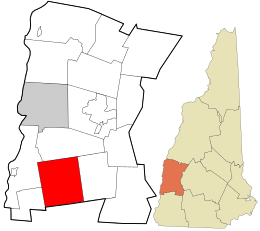Acworth, New Hampshire
| Acworth, New Hampshire | |
|---|---|
| Town | |
 Location in Sullivan County and the state of New Hampshire. |
|
| Coordinates: 43°13′04″N 72°17′31″W / 43.21778°N 72.29194°WCoordinates: 43°13′04″N 72°17′31″W / 43.21778°N 72.29194°W | |
| Country | United States |
| State | New Hampshire |
| County | Sullivan |
| Incorporated | 1772 |
| Government | |
| • Board of Selectmen | David Goodwin, Chair Frank Emig Steven Holt |
| Area | |
| • Total | 39.1 sq mi (101.3 km2) |
| • Land | 38.9 sq mi (100.7 km2) |
| • Water | 0.2 sq mi (0.6 km2) 0.61% |
| Elevation | 1,489 ft (454 m) |
| Population (2010) | |
| • Total | 891 |
| • Density | 23/sq mi (8.8/km2) |
| Time zone | Eastern (UTC-5) |
| • Summer (DST) | Eastern (UTC-4) |
| ZIP code | 03601 |
| Area code(s) | 603 |
| FIPS code | 33-00260 |
| GNIS feature ID | 0873525 |
| Website | homepages |
Acworth is a town in Sullivan County, New Hampshire, United States. At the 2010 census, the town had a total population of 891.
Originally chartered by Governor Benning Wentworth in 1752, it was called Burnet after William Burnet, a former governor of the Province of Massachusetts Bay. In 1754, however, the French and Indian War broke out, and no settlements were made under the charter. Wentworth regranted the township on 19 September 1766, naming it after Sir Jacob Acworth, a former Surveyor of the Royal Navy. The town was first permanently settled in 1768 by several families from Londonderry.
Acworth was incorporated in 1772 by Governor John Wentworth, but war again slowed its development. With the close of the Revolution, however, Acworth grew quickly. By 1859, it had 1,251 inhabitants, most of whom were occupied in agriculture. The Cold River provided water power for industry, including 5 sawmills, a gristmill, a woolen factory, a bobbin factory and a peg factory. There was also a boot and shoe manufacturer. Acworth is a source for museum-quality crystals such as beryl. The town of Acworth, Georgia was named for this town, because this was the hometown of a railroad engineer there.
...
Wikipedia
